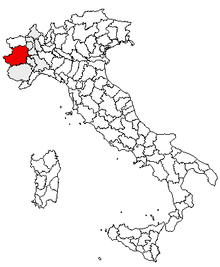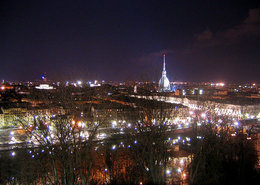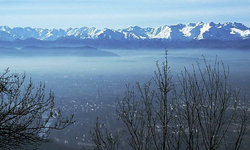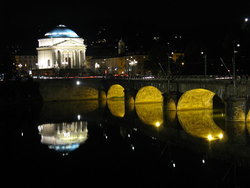Difference between revisions of "Turin, Italy"
m |
m (Turin moved to Turin, Italy) |
||
| (25 intermediate revisions by the same user not shown) | |||
| Line 1: | Line 1: | ||
| − | + | {{X}} | |
| − | {| border=1 | + | {| border=1 cellspacing=3 cellpadding=4 style="float:right; margin:0 0 .5em 1em; width:250px; background:#505050; border-collapse:collapse; border:1px solid #999; font-size:83%; line-height:1.5; " summary="Infobox Automobile" |
| + | |- style="text-align:center; background:#505050;" | ||
| + | | colspan=2 style="padding:0; background:#333333; color:#fff; border-bottom:1px solid #999;" |[[Image:Torino-Stemma.png|center|90px]] | ||
| + | |- style="color:#fff; background:darkred; font-size:larger;" | ||
| + | ! colspan=2 |'''City of Turin''' | ||
|- | |- | ||
| − | | | + | |Native name || Città di Torino |
|- | |- | ||
| − | | | + | |Established title || [[Ancient Rome|Roman]] foundation |
|- | |- | ||
| − | + | |Established date || 28 BC | |
|- | |- | ||
| − | | | + | |Nickname || "Automobile Capital" |
|- | |- | ||
| − | | | + | |Motto || |
|- | |- | ||
| − | | | + | |Website || http://www.comune.torino.it |
|- | |- | ||
| − | | | + | |Leader title || [[Mayor of Turin|Mayor]] |
|- | |- | ||
| − | |[[ | + | |Leader name || [[Sergio Chiamparino]] |
|- | |- | ||
| − | | | + | |Area magnitude || 1 E8 |
|- | |- | ||
| − | || | + | |Area total sq mi || 50.2 |
| + | |- | ||
| + | |Area total km2 || 130 | ||
| + | |- | ||
| + | |Population as of || December 2006 | ||
| + | |- | ||
| + | |Population total || 900,569 | ||
| + | |- | ||
| + | |Population urban || 1,700,000 | ||
| + | |- | ||
| + | |Area urban km2 || 650 | ||
| + | |- | ||
| + | |Area urban sq mi || 251 | ||
| + | |- | ||
| + | |Population metro || 2,200,000 | ||
| + | |- | ||
| + | |Population density km2 || 6,927 | ||
| + | |- | ||
| + | |Population density sq mi || 17,939 | ||
| + | |- | ||
| + | |Timezone || [[Central European Time|CET]] | ||
| + | |- | ||
| + | |Utc offset || +1 | ||
| + | |- | ||
| + | |Elevation m || +240 | ||
| + | |- | ||
| + | |Elevation ft || 788 | ||
| + | |- | ||
| + | |Postal code type || Postal codes | ||
| + | |- | ||
| + | |Postal code || 10100 | ||
| + | |- | ||
| + | |Area code || 011 | ||
| + | |- | ||
| + | |Blank name || Patron saint | ||
| + | |- | ||
| + | |Blank info || [[John the Baptist]] ([[24 June]]) | ||
| + | |- | ||
| + | |colspan=2|[[Image:Torino posizione.png|center|220px]] | ||
|} | |} | ||
| − | '''Turin''' ([[ | + | '''Turin''' ({{lang-it|Torino}}; [[Piedmontese language|Piedmontese]]: ''Turin'' pronounced [{{IPA|tyɾ'in}}]) is a major industrial [[city]] as well as a business and cultural centre in northern [[Italy]], [[capital (politics)|capital]] of the [[Piedmont (Italy)|Piedmont]] region, located mainly on the west [[Stream bed|bank]] of the [[Po River]]. The [[population]] of the city of Turin is 908,000 (2004 census); its [[agglomeration]] totals about 1.7 million inhabitants, while its [[metropolitan area]] has a population of 2.2 million of inhabitants (according to the [[OECD]][http://213.253.134.43/oecd/pdfs/browseit/0406041E.PDF]). The company [[Fiat]] [[automaker|automobile manufacturer]] has its headquarters here, so Turin has been nicknamed as the Automobile Capital of Italy. It was the first capital of the [[Italian unification|unified Italy]]. |
| + | [[Image:Torino-panoramadaicappuccini.jpg|thumb|right|260px]] | ||
| − | == History == | + | ==History== |
| − | + | ===Etymology=== | |
| − | + | The [[Italian language|Italian]] name, ''Torino'', translates as "little bull"; hence the coat of arms and the symbol of the city. The area was settled by the [[Taurini]] in pre-[[ancient Rome|Roman]] times. | |
| − | The area was settled by the [[Taurini]] in pre-[[Rome|Roman]] times | ||
| − | == | + | ===Roman Times=== |
| − | + | In the [[1st century BC|first century BC]] (probably 28 BC), the Romans created a military camp (''Castra Taurinorum''), later dedicated to [[Augustus]] (''Augusta Taurinorum''). The typical Roman street grid can still be seen in the modern city. Turin reached about 5,000 inhabitants at the time, all living inside the high walls. | |
| + | |||
| + | ===Middle Ages=== | ||
| + | After the fall of the Roman empire the city was conquered by the [[Lombards]], then the [[Franks]] of [[Charlemagne]] (773); in the 940s the ''[[March of Turin|Contea di Torino]]'' (or countship) was founded, until 1050 held by the [[Arduin of Ivrea|Arudinic]] dynasty and then, after the marriage of [[Adelaide of Susa]] with [[Humbert I of Savoy|Humbert Biancamano]]'s son [[Otto of Savoy|Otto]], by the family of the [[Counts of Savoy]]. While the dignity of count was held by the Bishop as count of Turin (1092-1130 and 1136-1191) it was ruled as a [[prince-bishopric]] by the Bishops. In 1230-1235 it was a lordship under the [[Marquess of Montferrat]], styled Lord of Turin. | ||
| + | At the end of the thirteenth century, when it was annexed to the [[Duchy of Savoy]], the city already had 20,000 inhabitants. Many of the gardens and palaces were built in the fifteenth century when the city was redesigned. The [[University of Turin|University]] was also founded during this period. | ||
| + | |||
| + | ===16-18th century=== | ||
| + | [[Emanuele Filiberto]] (Iron Head) made Turin the capital of the [[Duchy of Savoy]] in 1563. Piazza Reale, today named Piazza San Carlo and Via Nuova, today called Via Roma were added with the first enlargement of the walls, in the first half of the XVII century; in the same period the Royal palace (Palazzo Reale) was built. In the second half of that century, a second enlargement of the walls was planned and executed, with the building of the arcaded Via Po, connecting diagonally through the regular street grid Piazza Castello with the bridge on the Po. | ||
| + | In 1706, during the [[Battle of Turin]], the [[France|French]] besieged the city for 117 days without conquering it. After the subsequent [[Treaty of Utrecht]], the [[Kingdom of Sardinia]] was annexed to the Duchy of Savoy and the architect [[Filippo Juvarra]] began a major redesign of the city. Now the capital of a European kingdom, Turin had about 90,000 inhabitants at the time. | ||
| + | |||
| + | ===19th century=== | ||
| + | In the nineteenth century, after brief occupation by [[Napoleon I of France|Napoleon]], the city began to actively pursue the [[unification of Italy]]. In 1871, the [[Fréjus Rail Tunnel|Fréjus Tunnel]] was opened, making Turin an important communication node. The city now had 250,000 inhabitants. The [[Museo Egizio]], the [[Mole Antonelliana]], the [[Gran Madre]] church and Vittorio Veneto square were built in this period. | ||
| + | [[Image:Mg-k Torino Alpi.jpg|thumb|250px|right|View over Turin and Alps.]] | ||
| + | In 1861, Turin became the capital of the newly proclaimed United Italy. In 1864 the capital was moved to [[Florence]]. (Since [[8 July]] [[1871]], the capital has been [[Rome]].) Turin reacted to the loss of importance by beginning a rapid industrialisation: in 1899 [[FIAT]] was founded and [[Lancia]] in 1906. The [[Universal Exposition]] held in Turin in 1902 is often considered the pinnacle of [[Art Nouveau]] design, and the city hosted the Exposition again in 1911. By this time, Turin had grown to 430,000 inhabitants. | ||
| + | ===20th century=== | ||
| + | After [[World War I]], conflicts between workers and industrialists began. The first strikes took place and in 1920 the [[Lingotto]] factory was occupied. | ||
| + | |||
| + | After [[World War II]], Turin was rapidly rebuilt and its industries greatly developed, which caused waves of immigration, largely from the southern regions of Italy. The population reached 1 million in 1960 and peaked at 1.5 million in 1975. In the 1980s, the first industrial crisis hit the city and its population began to decline (and continues to, while the metropolitan area grows). The 2005 population is 908,000. | ||
| + | |||
| + | ==Law and government== | ||
| + | |||
| + | The mayor of Turin is directly elected every five years. [[Sergio Chiamparino]], the current mayor, belongs to the center-left coalition. | ||
| + | |||
| + | ==Districts== | ||
| + | Turin shares its municipality in 10 districts. | ||
| + | |||
| + | Municipal Districts does not correspond always to historical Districts of the city. | ||
| + | |||
| + | In the following list are listed historical Districts (named ''Circocrizioni'') included in Municipal districts. | ||
| + | |||
| + | * Circoscrizione 1 Centro - Crocetta | ||
| + | * Circoscrizione 2 Santa Rita - Mirafiori Nord | ||
| + | * Circoscrizione 3 San Paolo - Cenisia - Pozzo Strada - Cit Turin - Borgata Lesna | ||
| + | * Circoscrizione 4 San Donato - Campidoglio - Parella | ||
| + | * Circoscrizione 5 Borgo Vittoria - Madonna di Campagna - Lucento - Vallette | ||
| + | * Circoscrizione 6 Barriera di Milano - Regio Parco - Barca - Bertolla - Falchera - Rebaudengo - Villaretto | ||
| + | * Circoscrizione 7 [[Aurora (Turin)|Aurora]] - Vanchiglia - Sassi - Madonna del Pilone | ||
| + | * Circoscrizione 8 San Salvario - Cavoretto - Borgo Po | ||
| + | * Circoscrizione 9 Nizza Millefonti - Lingotto - Filadelfia | ||
| + | * Circoscrizione 10 Mirafiori Sud | ||
| + | |||
| + | ==Geography and climate== | ||
| + | Turin is located in northwest Italy. | ||
| + | It is surrounded on the western and northern front by the [[Alps]] and on the southern front by the hills of [[Monferrato]]. | ||
| + | Four major rivers pass through the city: the [[Po]] and two of its tributaries, the [[Dora Riparia]] (later changed to "Duria Minor" by the Romans, from the [[Celtic languages|Celtic]] ''duria'' meaning "water"), the [[Stura di Lanzo]], and the [[Sangone (disambiguation)|Sangone]]. | ||
| + | |||
| + | Turin has a truly continental climate, with nothing to share with the rest of [[Italy]] which is famous for its comfortable [[Mediterranean climate]]. | ||
| + | Winters are cold and dry, summers are cool in the hills and quite hot in the plains. During the winter and autumn months banks of fog, which are sometimes very thick, form in the plains.[http://www.comune.torino.it/canaleturismo/en/clima.htm] | ||
| − | |||
| − | |||
==Demographics== | ==Demographics== | ||
| − | + | In 2005, Turin city proper had a population of 902,255 up from 867,857 (+3.82 increase), while the metropolitan area contained a total 2,236,941 inhabitants. Like many cities in Italy, the population is highly aged as 14.5 percent of the population is under 18, while those of retirement age constitute 30.12 percent. Despite this, the population of Turin grew mostly from internal migrants from other areas of [[Italy]], as well as an increasing amount of foreigners particularly from [[Eastern Europe]].[http://demo.istat.it/pop2005/index.html] | |
| − | + | The city has seen a large influx of foreigners over the last few decades comprising just under 9 percent of the city's population consisted of foreigners, the largest being Romanian (23,114), Moroccan (14,134), Peruvian (5,502), Albanian (4,297), and Chinese (3,533).[http://demo.istat.it/str2005/index.html] | |
| − | |||
| − | |||
| − | |||
| − | |||
| − | + | ==Economy== | |
| + | Today the city is a major industrial center, where the headquarters and main production lines of the [[Automobile|car]] [[company (law)|company]] [[Fiat]] are located. The city is home to the [[Lingotto]] building, which was at one time the largest car factory in the [[world]], and now houses a [[convention centre]], a [[concert hall]], an art gallery, a shopping centre and a [[hotel]]. Other companies founded in Turin are [[Lancia]], [[Pininfarina]], [[Bertone]], [[Sparco]], [[Italdesign]], [[Ghia]], [[Fioravanti]], [[Stola]], [[Intesa Sanpaolo]], [[Superga (company)|Superga]], [[Invicta]] (1821), [[Luigi Lavazza|Lavazza]], [[Martini & Rossi]], [[Kappa (company)|Kappa]] and the chocolate factory [[Pierre Paul Caffarel|Caffarel]]. | ||
| − | + | The city is also well known for its aerospace industry ([[Alenia]]). The [[Multi-Purpose Logistics Module]]s for the [[International Space Station]] were produced in Turin. The future European launcher projects beyond [[Ariane 5]] will also be managed from Turin, by the new [[NGL Prime SpA|NGL]] company, a subsidiary of [[EADS]] (70%) and [[Finmeccanica]] (30%). | |
| − | |||
| − | + | Turin is also the birthplace of some of the country's main companies, such as [[Telecom Italia]] (telecommunications), [[RAI|Rai]] (television), and cinema. Most of these industries have since moved their headquarters to other parts of [[Italy]], but Turin still retains the National Museum of Cinema (in the Mole Antonelliana building). | |
| − | The | + | ==Transportation infrastructure== |
| + | The town currently has a large number of rail and road work sites. Although this activity has increased as a result of the [[2006 Winter Olympics]], parts of it had long been planned. Some of the work sites deal with general roadworks to improve traffic flow, such as underpasses and flyovers, but two projects are of major importance and will change the shape of the town radically. | ||
| − | + | One is the ''Spina'' ("spine") which includes the doubling of a major railroad crossing the town. The railroad previously ran in a trench, which will now be covered by a major boulevard. The town rail station on this line will become the main station of Turin (''Porta Susa''). | |
| − | The | + | The other major project is the construction of a subway line based on the [[VAL]] system, known as [[Metrotorino]]. This project is expected to continue for years and to cover a larger part of the town, but its first phase was finished in time for the Olympic Games (inaugurated on 4 February 2006 and opened to the public the day after). The first leg of the subway system linked the nearby town of [[Collegno]] with the [[Porta Susa]] station in Turin's town centre; a new leg (inaugurated on 4 of October 2007) extends now the service to the 'Porta Nuova' railway station. This underground transportation project has historical importance for Turin, as the town has dreamed of an underground line for decades, the first project dating as far back as the twenties. In fact, the main street in the town centre (''Via Roma'') runs atop a tunnel built during the fascist era (when ''Via Roma'' was built). The tunnel was supposed to host the underground line but is now used as an underground car park. A project to build an underground system was ready in the seventies, with government funding for it and for similar projects in [[Milan]] and [[Rome]]; whilst the other two cities went ahead with the projects, Turin local government led by mayor [[Diego Novelli]] shelved the proposal as it believed it to be too costly and unnecessary, but that only meant more funding for Rome and Milan. |
| + | The city has an international airport known as Caselle International Airport Sandro Pertini (TRN), located few kilometres from downtown and connected to the city by a railway service (from Dora Station) and a bus service (from Porta Nuova and Porta Susa railway stations). | ||
| + | ==Main sights== | ||
| + | :''For a complete list of Turin's landmarks, see: [[:category:Buildings and structures in Turin|Buildings and structures in Turin]] | ||
| + | {| align="right" cellpadding="0" cellspacing="0" | ||
| + | |- | ||
| + | | [[Image:Torino Torri Palatine.jpg|thumb|250px|The [[Palatine Towers]] (old photo).]] | ||
| + | |- | ||
| + | | [[Image:Porte Palatine Park.jpg|thumb|250px|The [[Palatine Towers]] nowadays, Archaeological Park.]] | ||
| + | |- | ||
| + | | [[Image:Torino-mole01.jpg|thumb|right|250px|The [[Mole Antonelliana]].]] | ||
| + | |- | ||
| + | | [[Image:Mg-k Torino Mole.jpg|thumb|right|250px|The [[Mole Antonelliana]].]] | ||
| + | |- | ||
| + | | [[Image:Mg-k Basilica Superga1.jpg|thumb|250px|The [[Basilica di Superga]] near Turin.]] | ||
| + | |- | ||
| + | | [[Image:Mg-k Basilica Superga2.jpg|thumb|250px|The [[Basilica di Superga]] near Turin.]] | ||
| + | |- | ||
| + | | [[Image:Mg-k Torino Carignano.jpg|thumb|250px|The façade of [[Palazzo Carignano]].]] | ||
| + | |- | ||
| + | | [[Image:Chiesa della Gran Madre a Torino.JPG|250px|thumb|right|The Gran Madre Church from the [[Mole Antonelliana]].]] | ||
| + | |- | ||
| + | | [[Image:Chiesa Gran Madre at Night.jpg|250px|thumb|right|The Gran Madre Church at night.]] | ||
| + | |- | ||
| + | | [[Image:Tramonto 1-12-05 1600 x 1200.jpg|250px|thumb|Sunset on the [[Po River]] in Turin]] | ||
| + | |} | ||
| + | The best known building of the city is the [[Mole Antonelliana]], whose construction began in 1863 and which today houses the National Cinema Museum. | ||
| − | + | The [[Palatine Towers]] are among the best preserved Roman remains in northern Italy. | |
| − | |||
| − | |||
| − | |||
| − | + | The [[Cathedral of Saint John the Baptist (Turin)|Cathedral of St John the Baptist]] houses the [[Shroud of Turin]], an old linen cloth with an imprint of a [[man]], which is believed by many to be the cloth that covered [[Jesus]] in his grave. | |
| − | |||
| − | |||
| − | |||
| − | |||
| − | |||
| − | |||
| − | == Universities == | + | Nearby is the former royal residence: the seventeenth-century [[Palazzo Reale (Turin)|Palazzo Reale]], built for Madama Reale [[Christine Marie of France]]. |
| − | *[[University of Turin]] ([[Universita degli Studi di Torino|Università degli Studi di Torino]]) | + | |
| − | + | The [[Museo Egizio]] has the most important collection of [[Egypt]]ian antiquities in the world after the Cairo Museum. | |
| + | |||
| + | Turin has buildings of great historical and architectural interest: the [[Savoy Residences]]. In addition to the Royal Palace (the official residence of the Savoys until 1865) there are many palaces, residences and castles in the city centre and in the surrounding towns. Turin is home to Palazzo Chiablese, the Royal Armoury, the Royal Library, [[Palazzo Madama, Turin|Palazzo Madama]], [[Palazzo Carignano]], [[Villa della Regina]], and the Valentino Castle. | ||
| + | |||
| + | The complex of the [[Residences of the Royal House of Savoy]] in Turin and in the nearby cities of Rivoli, Moncalieri, Venaria, Agliè, Racconigi, Stupinigi, Pollenzo and Govone was declared in 1997 a [[World Heritage Sites]] by [[UNESCO]]. | ||
| + | |||
| + | In the hills overlooking the city is the basilica church of [[Basilica of Superga|Superga]], providing a view of Turin against a backdrop of the snow-capped [[Alps]]. The basilica holds the tombs of many of the dukes of Savoy, as well as many of the kings of Sardinia. Superga can be reached by means of the [[Superga Rack Railway]] from the suburb of Sassi. | ||
| + | |||
| + | The city was the film set of the 1969 film ''[[The Italian Job]]'' and ''[[Deep Red]]'' (1975), directed by Italian horror filmmaker [[Dario Argento]]. | ||
| + | |||
| + | ==Universities== | ||
| + | *[[University of Turin]] ([[Universita degli Studi di Torino|Università degli Studi di Torino]]) | ||
| + | *[[Politecnico di Torino]] | ||
| + | |||
| + | ==Publishing and journalism== | ||
| + | After [[Alexandria]], [[Madrid]], [[New Delhi]], [[Antwerp]] and [[Montreal]], Turin has been chosen by [[United Nations Educational, Scientific and Cultural Organization|UNESCO]] as [[World Book Capital]] for the year 2006. The [[Turin International Book Fair|International Book Fair]] is one of the most important fairs of its kind in Europe. | ||
| + | |||
| + | Turin is home to one of Italy’s principal national newspapers, [[La Stampa]], and to the sports daily [[Tuttosport]]. | ||
| + | |||
| + | ==Sport== | ||
| + | ===Rowing=== | ||
| + | Turin was the city where the [[Fédération Internationale des Sociétés d'Aviron|FISA]] (international rowing federation) was born in 1892. | ||
| + | |||
| + | ===Football=== | ||
| + | The city is famous for two very successful [[Football (soccer)|football]] teams: [[Juventus F.C.]] (founded 1897), and [[Torino F.C.]] (founded 1906). | ||
| + | |||
| + | [[Juventus F.C.]] is a very popular football club in Italy {{Fact|date=October 2007}}, and historically one of the most prestigious and glorious [[football (soccer)|football]] [[club]]s in the world, having won a total of 51 official trophies: 40 in Italian tournaments and 11 in the international competitions, Only Boca Juniors -with 16 titles- and other three clubs: Independiente, Real Madrid and Milan -all with 15 titles- have won more official international titles in the world.</ref> all recognized by [[UEFA|Union of European Football Association]] and [[FIFA|International Federation of Association Football]]. | ||
| + | |||
| + | In 1949, a plane carrying the whole [[Torino F.C.]] team (at that time the most important in Italy and known as the [[Grande Torino]]) [[Superga air disaster|hit the church of Superga]], on the Turin hills. [[Valentino Mazzola]] (one of the best Italian players of all times), father of Ferruccio and [[Sandro Mazzola]] (who were later to become football champions) were among those who died. | ||
| + | |||
| + | ===Olympic Games=== | ||
| + | Turin was the host of the [[2006 Winter Olympics]]. | ||
| + | |||
| + | ===Other international championships hosted=== | ||
| + | ;1934 : [[1934 European Championships in Athletics]] | ||
| + | ;1959 : [[1959 Summer Universiade|I Summer Universiade]] | ||
| + | ;1970 : [[1970 Summer Universiade|VI Summer Universiade]] | ||
| + | ;2005 : [[Figure Skating European Championship]] | ||
| + | ;2006 : [[37th Chess Olympiad]] | ||
| + | :World [[fencing (sport)|Fencing]] Championship ([http://www.escrime-torino2006.com/eng/ Official site]) | ||
| + | ;2007 : [[2007 Winter Universiade|Winter Universiade Games]] | ||
| + | ;2008 : 23rd European [[Rhythmic Gymnastics]] (Calisthenics) Championships | ||
| + | ;2009 : IAAF European Indoor Championships in Athletics | ||
| + | ;2010 : [[Figure Skating World Championship]] | ||
| + | |||
| + | |||
| + | ===Other sports=== | ||
| + | ====Volleyball==== | ||
| + | The ''C.U.S. Torino'' volleyball team won 4 times the domestic league and, in season 1979/80 the Volleyball European Champion's Cup. It was the first team from western Europe to win this competition. In the 1990s, the team had been dismantled due to economical issues. | ||
| + | ====Hit ball==== | ||
| + | [[Hit ball]] was invented in Turin | ||
| + | |||
| + | ==Chocolate== | ||
| + | Turin is the birth place of solid chocolate. It was in Turin that, at the end of the 18th century, Mr. [[Doret]] invented a revolutionary machine that could make solid chocolate (as opposed to drinking chocolate). Turin chocolate firms produce a typical [[chocolate]], called ''[[Gianduiotto]]'', named after [[Gianduja]], a local [[Commedia dell'arte]] mask; plus many other kinds of chocolate. Every year the town organizes ''CioccolaTÒ'', a two-week chocolate festival run with the main Piedmontese chocolate producers, such as [[Venchi]] and others, as well as some big international companies, such as [[Lindt & Sprüngli]]. | ||
| + | |||
| + | ==Nearby towns== | ||
| + | Turin is surrounded by several smaller cities in the Province of Turin such as [[Grugliasco]], [[Rivoli (Italy)|Rivoli]], [[Chivasso]], [[Venaria Reale|Venaria]], [[Settimo Torinese]], [[Orbassano]], [[Moncalieri]], [[Avigliana]], [[Buttigliera Alta]], [[Gassino Torinese]], [[Nichelino]], [[Collegno]], [[Pino Torinese]], [[Chieri]], [[Ciriè]], [[Ivrea]], [[Pinerolo]], [[Borgaretto]] and others, that make up one of Italy's primary metropolitan areas. | ||
| + | |||
| + | ==Notable natives== | ||
| + | * [[Giovanni Agnelli]] (1866-1945), founder of [[FIAT]]. | ||
| + | * [[Gianni Agnelli]] (1921-2003), influential chairman director of [[FIAT]]. | ||
| + | * [[Giuliano Amato]] (born 1938), politician, former Prime Minister of [[Italy]]. | ||
| + | * [[Amedeo Avogadro]] (1776-1856), [[Physics|physicist]]. | ||
| + | * [[Alessandro Baricco]] (born 1958), writer. | ||
| + | * [[Fred Buscaglione]] (1921-1960), singer and songwriter. | ||
| + | * [[Giuseppe Marc'Antonio Baretti]] (1719-1789), critic. | ||
| + | * [[Count Camillo Benso di Cavour|Camillo Benso, count of Cavour]], politician ([[Italian unification]]). | ||
| + | * [[Norberto Bobbio]] (1909-2004), historian and philosopher. | ||
| + | * [[Arturo Brachetti]] | ||
| + | * [[Carla Bruni]] (born 1968), supermodel. | ||
| + | * [[Pierre Paul Caffarel]] (1795-1850), founder of the first [[chocolate]] factory in the world. | ||
| + | * [[Antonio Benedetto Carpano]] (1764-1815), inventor of [[vermouth]] and [[apéritif]]. | ||
| + | * [[Leo Chiosso]] (1920-2006), lyricist, songwriter with [[Fred Buscaglione]]. | ||
| + | * [[Robert Fano]] (1917-2004), engineer. | ||
| + | * [[Galileo Ferraris]] (1847-1897), physicist and electrical engineer. | ||
| + | * [[Piero Gobetti]] (1901-1926), intellectual. | ||
| + | * [[Joseph Louis Lagrange]] (1736-1813), mathematician. | ||
| + | * [[Vincenzo Lancia]] (1881-1937), sportsman and businessman, founder of [[Lancia]]. | ||
| + | * [[Luigi Lavazza]] (1859-1949), inventor and [[coffee]] businessman. | ||
| + | * [[Carlo Levi]] (1902-1975), painter and writer. | ||
| + | * [[Primo Levi]] (1919-1987), chemist, philosopher, [[Holocaust]] survivor and writer. | ||
| + | * [[Salvador Edward Luria]] (1912-1991), winner of the Nobel Prize in Physiology or Medicine. | ||
| + | * [[Alessandro Martini]] (1812-1905), vermouth businessman. | ||
| + | * [[Mau Mau (band)|Mau Mau]] (formed 1991), rock band. | ||
| + | * [[Carlo Mollino]] (1905-1973), architect and designer. | ||
| + | * [[Rita Levi-Montalcini]] (1909), winner of the Nobel Prize in Physiology or Medicine. | ||
| + | * [[Adriano Olivetti]] (1901-1960), businessman. | ||
| + | * [[Giuseppe Peano]] (1858-1932), mathematician. | ||
| + | * [[Aurelio Peccei]] (1908-1984), founder of the [[Club of Rome]]. | ||
| + | * [[Gabry Ponte]], DJ member of [[Eiffel 65]]. | ||
| + | * [[Tullio Regge]] (born 1931), physicist | ||
| + | * [[Piero Sraffa]] (1898-1983), economist. | ||
| + | * [[Subsonica]] (formed 1996), rock band. | ||
| + | * [[Massimo Taparelli, marquis d'Azeglio]] (1798-1866), statesman, novelist and painter. | ||
| + | * [[Umberto Tozzi]] (1952), singer. | ||
| + | * [[Gianni Vattimo]] (1936), philosopher. | ||
| + | * [[Victor Emmanuel II of Italy]] (1820-1878), King of [[Piedmont]] and the first King of the united Italy. | ||
| + | |||
| + | ==Notable residents== | ||
| + | |||
| + | * [[Alessandro Del Piero]] | ||
| + | * [[Edmondo de Amicis]] | ||
| + | * [[St. John Bosco]] | ||
| + | * [[Francesco Faà di Bruno]] | ||
| + | * [[Italo Calvino]] | ||
| + | * [[Gaspare Campari]] | ||
| + | * [[Francesco Cirio]] | ||
| + | * [[Renato Dulbecco]] | ||
| + | * [[Umberto Eco]] | ||
| + | * [[Luigi Einaudi]] | ||
| + | * [[Erasmus]] | ||
| + | * [[Guido Fubini]] | ||
| + | * [[Natalia Ginzburg]] | ||
| + | * [[Antonio Gramsci]] | ||
| + | * [[Primo Levi]] | ||
| + | * [[Cesare Lombroso]] | ||
| + | * [[Claudio Magris]] | ||
| + | * [[Joseph de Maistre]] | ||
| + | * [[Giulio Natta]] | ||
| + | * [[Friedrich Nietzsche]] | ||
| + | * [[Vilfredo Pareto]] | ||
| + | * [[Cesare Pavese]] | ||
| + | * [[Jean-Jacques Rousseau]] | ||
| + | * [[Emilio Salgari]] | ||
| + | * [[Ascanio Sobrero]] | ||
| + | * [[Germain Sommeiller]] | ||
| + | * [[Gianni Vattimo]] | ||
| + | * [[Elio Vittorini]] | ||
| + | |||
| + | ==Twin cities== | ||
| + | {| border="0" | ||
| + | |- | ||
| + | |valign="top"| | ||
| + | |||
| + | * {{flagiconEUR}} European | ||
| + | ** {{flagiconFRA}} [[Chambéry]], [[France]] | ||
| + | ** {{flagiconGER}} [[Cologne]], [[Germany]] | ||
| + | ** {{flagiconLUX}} [[Esch-sur-Alzette]], [[Luxemburg]] | ||
| + | ** {{flagiconGBR}} [[Glasgow]], [[United Kingdom]] | ||
| + | ** {{flagiconBEL}} [[Liège]], [[Belgium]] | ||
| + | ** {{flagiconFRA}} [[Lille]], [[France]] | ||
| + | ** {{flagiconNED}} [[Rotterdam]], [[Netherlands]] | ||
| + | |valign="top"| | ||
| + | * America | ||
| + | ** {{flagiconBRA}} [[Campo Grande]], [[Brazil]] | ||
| + | ** {{flagiconARG}} [[Córdoba (Argentina)|Córdoba]], [[Argentina]] | ||
| + | ** {{flagiconUSA}} [[Detroit]], [[United States|USA]] | ||
| + | ** {{flagiconGUA}} [[Quetzaltenango]], [[Guatemala]] | ||
| + | ** {{flagiconUSA}} [[Salt Lake City]], [[United States|USA]] | ||
| + | |valign="top"| | ||
| + | * Asia | ||
| + | ** {{flagiconPSE}} [[Gaza]], [[Palestinian National Authority]] | ||
| + | ** {{flagiconISR}} [[Haifa]], [[Israel]] | ||
| + | ** {{flagiconJPN}} [[Nagoya]], [[Japan]] | ||
| + | ** {{flagiconCHN}} [[Shenyang]], [[China]] | ||
| + | |} | ||
| − | |||
| − | |||
| − | |||
| − | |||
| − | |||
| − | |||
| − | == | + | ==External links== |
| − | |||
| − | + | * [http://www.comune.torino.it The official institutional site] — website version is in [[Italian language|Italian]] - Also some pages in [[English language|English]], [[German language|German]], [[Spanish language|Spanish]], [[French language|French]], [[Romanian language|Romanian]], [[Arabic Language|Arabic]], and [[Albanian Language|Albanian]] | |
| − | + | * [http://www.turismotorino.org/index.php?id=512&navCmd=reset Turismo Torino] The official tourist guide, available in [[English language|English]], [[Italian language|Italian]], [[French language|French]], [[Spanish language|Spanish]] and [[German language|German]]. | |
| + | * [http://www.torino2006.org/ Turin 2006 Olympic Games] — [[English language|English]], [[Italian language|Italian]] and [[French language|French]]. Website version is in [[Italian language|Italian]]. | ||
| + | * [http://citymayors.com/interviews/turin_interview.html CityMayors article]. | ||
| + | * [http://www.universiadetorino2007.org/ENG/HomeENG.asp Winter Universiade Torino 2007] — [[English language|English]], [[Italian language|Italian]] and [[French language|French]]. Website Version is [[Italian language|Italian]]. | ||
| + | *[http://www.torinofilmfest.org/index.php?lang=eng Torino Film Festival] | ||
| + | * [http://www.fieralibro.it/ International Book Fair]. | ||
| + | * [http://www.museonazionaledelcinema.org/ National Cinema Museum of Italy]. | ||
| + | * [http://www.flickr.com/photos/87095245@N00/sets/1480109/ Postcards from Turin]. | ||
| + | *[http://www.worldstatesmen.org/Italy_states2.htm WorldStatesmen- Italy] | ||
| − | + | {{Province of Turin}} | |
| − | + | {{Regional Capitals of Italy}} | |
| − | |||
| − | |||
| − | |||
| − | |||
| − | |||
| − | |||
| − | |||
| − | |||
| − | |||
| − | |||
| − | |||
| − | |||
| − | |||
| − | |||
| − | |||
| − | |||
| − | |||
| − | |||
| − | |||
| − | |||
| − | |||
| − | |||
| − | |||
| − | |||
| − | |||
| − | |||
| − | |||
| − | |||
| − | |||
| − | |||
| − | |||
| − | |||
| − | |||
| − | |||
| − | |||
| − | |||
| − | |||
| − | |||
| − | |||
| − | |||
| − | |||
| − | |||
| − | |||
| − | |||
| − | |||
| − | |||
| − | |||
| − | |||
| − | |||
| − | |||
| − | |||
| − | |||
| − | |||
| − | |||
| − | |||
| − | |||
| − | |||
| − | |||
| − | |||
| − | |||
| − | |||
| − | |||
| − | |||
| − | |||
[[Category:Turin]] | [[Category:Turin]] | ||
| − | [[Category: | + | [[Category:Roman colonies]] |
| − | [[Category: | + | [[Category:Roman towns and cities in Italy]] |
| − | [[Category: | + | [[Category:Province of Turin]] |
Latest revision as of 16:46, 27 February 2009
| City of Turin | |
|---|---|
| Native name | Città di Torino |
| Established title | Roman foundation |
| Established date | 28 BC |
| Nickname | "Automobile Capital" |
| Motto | |
| Website | http://www.comune.torino.it |
| Leader title | Mayor |
| Leader name | Sergio Chiamparino |
| Area magnitude | 1 E8 |
| Area total sq mi | 50.2 |
| Area total km2 | 130 |
| Population as of | December 2006 |
| Population total | 900,569 |
| Population urban | 1,700,000 |
| Area urban km2 | 650 |
| Area urban sq mi | 251 |
| Population metro | 2,200,000 |
| Population density km2 | 6,927 |
| Population density sq mi | 17,939 |
| Timezone | CET |
| Utc offset | +1 |
| Elevation m | +240 |
| Elevation ft | 788 |
| Postal code type | Postal codes |
| Postal code | 10100 |
| Area code | 011 |
| Blank name | Patron saint |
| Blank info | John the Baptist (24 June) |
Turin (Italian: Torino; Piedmontese: Turin pronounced [tyɾ'in]) is a major industrial city as well as a business and cultural centre in northern Italy, capital of the Piedmont region, located mainly on the west bank of the Po River. The population of the city of Turin is 908,000 (2004 census); its agglomeration totals about 1.7 million inhabitants, while its metropolitan area has a population of 2.2 million of inhabitants (according to the OECD[1]). The company Fiat automobile manufacturer has its headquarters here, so Turin has been nicknamed as the Automobile Capital of Italy. It was the first capital of the unified Italy.
History
Etymology
The Italian name, Torino, translates as "little bull"; hence the coat of arms and the symbol of the city. The area was settled by the Taurini in pre-Roman times.
Roman Times
In the first century BC (probably 28 BC), the Romans created a military camp (Castra Taurinorum), later dedicated to Augustus (Augusta Taurinorum). The typical Roman street grid can still be seen in the modern city. Turin reached about 5,000 inhabitants at the time, all living inside the high walls.
Middle Ages
After the fall of the Roman empire the city was conquered by the Lombards, then the Franks of Charlemagne (773); in the 940s the Contea di Torino (or countship) was founded, until 1050 held by the Arudinic dynasty and then, after the marriage of Adelaide of Susa with Humbert Biancamano's son Otto, by the family of the Counts of Savoy. While the dignity of count was held by the Bishop as count of Turin (1092-1130 and 1136-1191) it was ruled as a prince-bishopric by the Bishops. In 1230-1235 it was a lordship under the Marquess of Montferrat, styled Lord of Turin. At the end of the thirteenth century, when it was annexed to the Duchy of Savoy, the city already had 20,000 inhabitants. Many of the gardens and palaces were built in the fifteenth century when the city was redesigned. The University was also founded during this period.
16-18th century
Emanuele Filiberto (Iron Head) made Turin the capital of the Duchy of Savoy in 1563. Piazza Reale, today named Piazza San Carlo and Via Nuova, today called Via Roma were added with the first enlargement of the walls, in the first half of the XVII century; in the same period the Royal palace (Palazzo Reale) was built. In the second half of that century, a second enlargement of the walls was planned and executed, with the building of the arcaded Via Po, connecting diagonally through the regular street grid Piazza Castello with the bridge on the Po. In 1706, during the Battle of Turin, the French besieged the city for 117 days without conquering it. After the subsequent Treaty of Utrecht, the Kingdom of Sardinia was annexed to the Duchy of Savoy and the architect Filippo Juvarra began a major redesign of the city. Now the capital of a European kingdom, Turin had about 90,000 inhabitants at the time.
19th century
In the nineteenth century, after brief occupation by Napoleon, the city began to actively pursue the unification of Italy. In 1871, the Fréjus Tunnel was opened, making Turin an important communication node. The city now had 250,000 inhabitants. The Museo Egizio, the Mole Antonelliana, the Gran Madre church and Vittorio Veneto square were built in this period.
In 1861, Turin became the capital of the newly proclaimed United Italy. In 1864 the capital was moved to Florence. (Since 8 July 1871, the capital has been Rome.) Turin reacted to the loss of importance by beginning a rapid industrialisation: in 1899 FIAT was founded and Lancia in 1906. The Universal Exposition held in Turin in 1902 is often considered the pinnacle of Art Nouveau design, and the city hosted the Exposition again in 1911. By this time, Turin had grown to 430,000 inhabitants.
20th century
After World War I, conflicts between workers and industrialists began. The first strikes took place and in 1920 the Lingotto factory was occupied.
After World War II, Turin was rapidly rebuilt and its industries greatly developed, which caused waves of immigration, largely from the southern regions of Italy. The population reached 1 million in 1960 and peaked at 1.5 million in 1975. In the 1980s, the first industrial crisis hit the city and its population began to decline (and continues to, while the metropolitan area grows). The 2005 population is 908,000.
Law and government
The mayor of Turin is directly elected every five years. Sergio Chiamparino, the current mayor, belongs to the center-left coalition.
Districts
Turin shares its municipality in 10 districts.
Municipal Districts does not correspond always to historical Districts of the city.
In the following list are listed historical Districts (named Circocrizioni) included in Municipal districts.
- Circoscrizione 1 Centro - Crocetta
- Circoscrizione 2 Santa Rita - Mirafiori Nord
- Circoscrizione 3 San Paolo - Cenisia - Pozzo Strada - Cit Turin - Borgata Lesna
- Circoscrizione 4 San Donato - Campidoglio - Parella
- Circoscrizione 5 Borgo Vittoria - Madonna di Campagna - Lucento - Vallette
- Circoscrizione 6 Barriera di Milano - Regio Parco - Barca - Bertolla - Falchera - Rebaudengo - Villaretto
- Circoscrizione 7 Aurora - Vanchiglia - Sassi - Madonna del Pilone
- Circoscrizione 8 San Salvario - Cavoretto - Borgo Po
- Circoscrizione 9 Nizza Millefonti - Lingotto - Filadelfia
- Circoscrizione 10 Mirafiori Sud
Geography and climate
Turin is located in northwest Italy. It is surrounded on the western and northern front by the Alps and on the southern front by the hills of Monferrato. Four major rivers pass through the city: the Po and two of its tributaries, the Dora Riparia (later changed to "Duria Minor" by the Romans, from the Celtic duria meaning "water"), the Stura di Lanzo, and the Sangone.
Turin has a truly continental climate, with nothing to share with the rest of Italy which is famous for its comfortable Mediterranean climate. Winters are cold and dry, summers are cool in the hills and quite hot in the plains. During the winter and autumn months banks of fog, which are sometimes very thick, form in the plains.[2]
Demographics
In 2005, Turin city proper had a population of 902,255 up from 867,857 (+3.82 increase), while the metropolitan area contained a total 2,236,941 inhabitants. Like many cities in Italy, the population is highly aged as 14.5 percent of the population is under 18, while those of retirement age constitute 30.12 percent. Despite this, the population of Turin grew mostly from internal migrants from other areas of Italy, as well as an increasing amount of foreigners particularly from Eastern Europe.[3]
The city has seen a large influx of foreigners over the last few decades comprising just under 9 percent of the city's population consisted of foreigners, the largest being Romanian (23,114), Moroccan (14,134), Peruvian (5,502), Albanian (4,297), and Chinese (3,533).[4]
Economy
Today the city is a major industrial center, where the headquarters and main production lines of the car company Fiat are located. The city is home to the Lingotto building, which was at one time the largest car factory in the world, and now houses a convention centre, a concert hall, an art gallery, a shopping centre and a hotel. Other companies founded in Turin are Lancia, Pininfarina, Bertone, Sparco, Italdesign, Ghia, Fioravanti, Stola, Intesa Sanpaolo, Superga, Invicta (1821), Lavazza, Martini & Rossi, Kappa and the chocolate factory Caffarel.
The city is also well known for its aerospace industry (Alenia). The Multi-Purpose Logistics Modules for the International Space Station were produced in Turin. The future European launcher projects beyond Ariane 5 will also be managed from Turin, by the new NGL company, a subsidiary of EADS (70%) and Finmeccanica (30%).
Turin is also the birthplace of some of the country's main companies, such as Telecom Italia (telecommunications), Rai (television), and cinema. Most of these industries have since moved their headquarters to other parts of Italy, but Turin still retains the National Museum of Cinema (in the Mole Antonelliana building).
Transportation infrastructure
The town currently has a large number of rail and road work sites. Although this activity has increased as a result of the 2006 Winter Olympics, parts of it had long been planned. Some of the work sites deal with general roadworks to improve traffic flow, such as underpasses and flyovers, but two projects are of major importance and will change the shape of the town radically.
One is the Spina ("spine") which includes the doubling of a major railroad crossing the town. The railroad previously ran in a trench, which will now be covered by a major boulevard. The town rail station on this line will become the main station of Turin (Porta Susa).
The other major project is the construction of a subway line based on the VAL system, known as Metrotorino. This project is expected to continue for years and to cover a larger part of the town, but its first phase was finished in time for the Olympic Games (inaugurated on 4 February 2006 and opened to the public the day after). The first leg of the subway system linked the nearby town of Collegno with the Porta Susa station in Turin's town centre; a new leg (inaugurated on 4 of October 2007) extends now the service to the 'Porta Nuova' railway station. This underground transportation project has historical importance for Turin, as the town has dreamed of an underground line for decades, the first project dating as far back as the twenties. In fact, the main street in the town centre (Via Roma) runs atop a tunnel built during the fascist era (when Via Roma was built). The tunnel was supposed to host the underground line but is now used as an underground car park. A project to build an underground system was ready in the seventies, with government funding for it and for similar projects in Milan and Rome; whilst the other two cities went ahead with the projects, Turin local government led by mayor Diego Novelli shelved the proposal as it believed it to be too costly and unnecessary, but that only meant more funding for Rome and Milan. The city has an international airport known as Caselle International Airport Sandro Pertini (TRN), located few kilometres from downtown and connected to the city by a railway service (from Dora Station) and a bus service (from Porta Nuova and Porta Susa railway stations).
Main sights
- For a complete list of Turin's landmarks, see: Buildings and structures in Turin
 The Palatine Towers (old photo). |
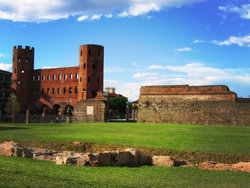 The Palatine Towers nowadays, Archaeological Park. |
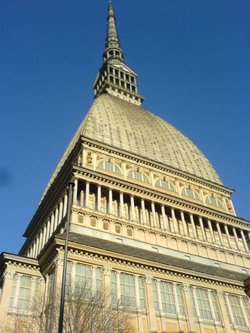 The Mole Antonelliana. |
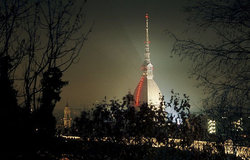 The Mole Antonelliana. |
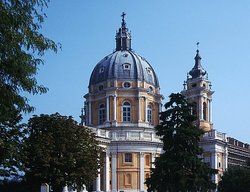 The Basilica di Superga near Turin. |
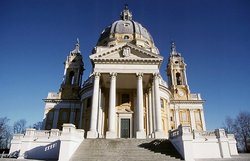 The Basilica di Superga near Turin. |
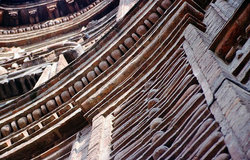 The façade of Palazzo Carignano. |
 The Gran Madre Church from the Mole Antonelliana. |
 Sunset on the Po River in Turin |
The best known building of the city is the Mole Antonelliana, whose construction began in 1863 and which today houses the National Cinema Museum.
The Palatine Towers are among the best preserved Roman remains in northern Italy.
The Cathedral of St John the Baptist houses the Shroud of Turin, an old linen cloth with an imprint of a man, which is believed by many to be the cloth that covered Jesus in his grave.
Nearby is the former royal residence: the seventeenth-century Palazzo Reale, built for Madama Reale Christine Marie of France.
The Museo Egizio has the most important collection of Egyptian antiquities in the world after the Cairo Museum.
Turin has buildings of great historical and architectural interest: the Savoy Residences. In addition to the Royal Palace (the official residence of the Savoys until 1865) there are many palaces, residences and castles in the city centre and in the surrounding towns. Turin is home to Palazzo Chiablese, the Royal Armoury, the Royal Library, Palazzo Madama, Palazzo Carignano, Villa della Regina, and the Valentino Castle.
The complex of the Residences of the Royal House of Savoy in Turin and in the nearby cities of Rivoli, Moncalieri, Venaria, Agliè, Racconigi, Stupinigi, Pollenzo and Govone was declared in 1997 a World Heritage Sites by UNESCO.
In the hills overlooking the city is the basilica church of Superga, providing a view of Turin against a backdrop of the snow-capped Alps. The basilica holds the tombs of many of the dukes of Savoy, as well as many of the kings of Sardinia. Superga can be reached by means of the Superga Rack Railway from the suburb of Sassi.
The city was the film set of the 1969 film The Italian Job and Deep Red (1975), directed by Italian horror filmmaker Dario Argento.
Universities
Publishing and journalism
After Alexandria, Madrid, New Delhi, Antwerp and Montreal, Turin has been chosen by UNESCO as World Book Capital for the year 2006. The International Book Fair is one of the most important fairs of its kind in Europe.
Turin is home to one of Italy’s principal national newspapers, La Stampa, and to the sports daily Tuttosport.
Sport
Rowing
Turin was the city where the FISA (international rowing federation) was born in 1892.
Football
The city is famous for two very successful football teams: Juventus F.C. (founded 1897), and Torino F.C. (founded 1906).
Juventus F.C. is a very popular football club in Italy Template:Fact, and historically one of the most prestigious and glorious football clubs in the world, having won a total of 51 official trophies: 40 in Italian tournaments and 11 in the international competitions, Only Boca Juniors -with 16 titles- and other three clubs: Independiente, Real Madrid and Milan -all with 15 titles- have won more official international titles in the world.</ref> all recognized by Union of European Football Association and International Federation of Association Football.
In 1949, a plane carrying the whole Torino F.C. team (at that time the most important in Italy and known as the Grande Torino) hit the church of Superga, on the Turin hills. Valentino Mazzola (one of the best Italian players of all times), father of Ferruccio and Sandro Mazzola (who were later to become football champions) were among those who died.
Olympic Games
Turin was the host of the 2006 Winter Olympics.
Other international championships hosted
- 1934
- 1934 European Championships in Athletics
- 1959
- I Summer Universiade
- 1970
- VI Summer Universiade
- 2005
- Figure Skating European Championship
- 2006
- 37th Chess Olympiad
- World Fencing Championship (Official site)
- 2007
- Winter Universiade Games
- 2008
- 23rd European Rhythmic Gymnastics (Calisthenics) Championships
- 2009
- IAAF European Indoor Championships in Athletics
- 2010
- Figure Skating World Championship
Other sports
Volleyball
The C.U.S. Torino volleyball team won 4 times the domestic league and, in season 1979/80 the Volleyball European Champion's Cup. It was the first team from western Europe to win this competition. In the 1990s, the team had been dismantled due to economical issues.
Hit ball
Hit ball was invented in Turin
Chocolate
Turin is the birth place of solid chocolate. It was in Turin that, at the end of the 18th century, Mr. Doret invented a revolutionary machine that could make solid chocolate (as opposed to drinking chocolate). Turin chocolate firms produce a typical chocolate, called Gianduiotto, named after Gianduja, a local Commedia dell'arte mask; plus many other kinds of chocolate. Every year the town organizes CioccolaTÒ, a two-week chocolate festival run with the main Piedmontese chocolate producers, such as Venchi and others, as well as some big international companies, such as Lindt & Sprüngli.
Nearby towns
Turin is surrounded by several smaller cities in the Province of Turin such as Grugliasco, Rivoli, Chivasso, Venaria, Settimo Torinese, Orbassano, Moncalieri, Avigliana, Buttigliera Alta, Gassino Torinese, Nichelino, Collegno, Pino Torinese, Chieri, Ciriè, Ivrea, Pinerolo, Borgaretto and others, that make up one of Italy's primary metropolitan areas.
Notable natives
- Giovanni Agnelli (1866-1945), founder of FIAT.
- Gianni Agnelli (1921-2003), influential chairman director of FIAT.
- Giuliano Amato (born 1938), politician, former Prime Minister of Italy.
- Amedeo Avogadro (1776-1856), physicist.
- Alessandro Baricco (born 1958), writer.
- Fred Buscaglione (1921-1960), singer and songwriter.
- Giuseppe Marc'Antonio Baretti (1719-1789), critic.
- Camillo Benso, count of Cavour, politician (Italian unification).
- Norberto Bobbio (1909-2004), historian and philosopher.
- Arturo Brachetti
- Carla Bruni (born 1968), supermodel.
- Pierre Paul Caffarel (1795-1850), founder of the first chocolate factory in the world.
- Antonio Benedetto Carpano (1764-1815), inventor of vermouth and apéritif.
- Leo Chiosso (1920-2006), lyricist, songwriter with Fred Buscaglione.
- Robert Fano (1917-2004), engineer.
- Galileo Ferraris (1847-1897), physicist and electrical engineer.
- Piero Gobetti (1901-1926), intellectual.
- Joseph Louis Lagrange (1736-1813), mathematician.
- Vincenzo Lancia (1881-1937), sportsman and businessman, founder of Lancia.
- Luigi Lavazza (1859-1949), inventor and coffee businessman.
- Carlo Levi (1902-1975), painter and writer.
- Primo Levi (1919-1987), chemist, philosopher, Holocaust survivor and writer.
- Salvador Edward Luria (1912-1991), winner of the Nobel Prize in Physiology or Medicine.
- Alessandro Martini (1812-1905), vermouth businessman.
- Mau Mau (formed 1991), rock band.
- Carlo Mollino (1905-1973), architect and designer.
- Rita Levi-Montalcini (1909), winner of the Nobel Prize in Physiology or Medicine.
- Adriano Olivetti (1901-1960), businessman.
- Giuseppe Peano (1858-1932), mathematician.
- Aurelio Peccei (1908-1984), founder of the Club of Rome.
- Gabry Ponte, DJ member of Eiffel 65.
- Tullio Regge (born 1931), physicist
- Piero Sraffa (1898-1983), economist.
- Subsonica (formed 1996), rock band.
- Massimo Taparelli, marquis d'Azeglio (1798-1866), statesman, novelist and painter.
- Umberto Tozzi (1952), singer.
- Gianni Vattimo (1936), philosopher.
- Victor Emmanuel II of Italy (1820-1878), King of Piedmont and the first King of the united Italy.
Notable residents
- Alessandro Del Piero
- Edmondo de Amicis
- St. John Bosco
- Francesco Faà di Bruno
- Italo Calvino
- Gaspare Campari
- Francesco Cirio
- Renato Dulbecco
- Umberto Eco
- Luigi Einaudi
- Erasmus
- Guido Fubini
- Natalia Ginzburg
- Antonio Gramsci
- Primo Levi
- Cesare Lombroso
- Claudio Magris
- Joseph de Maistre
- Giulio Natta
- Friedrich Nietzsche
- Vilfredo Pareto
- Cesare Pavese
- Jean-Jacques Rousseau
- Emilio Salgari
- Ascanio Sobrero
- Germain Sommeiller
- Gianni Vattimo
- Elio Vittorini
Twin cities
|
External links
- The official institutional site — website version is in Italian - Also some pages in English, German, Spanish, French, Romanian, Arabic, and Albanian
- Turismo Torino The official tourist guide, available in English, Italian, French, Spanish and German.
- Turin 2006 Olympic Games — English, Italian and French. Website version is in Italian.
- CityMayors article.
- Winter Universiade Torino 2007 — English, Italian and French. Website Version is Italian.
- Torino Film Festival
- International Book Fair.
- National Cinema Museum of Italy.
- Postcards from Turin.
- WorldStatesmen- Italy
| L'Aquila (Abruzzo) · Aosta (Aosta Valley) · Bari(Apulia) · Potenza (Basilicata) · Catanzaro (Calabria) · Naples (Campania) · Bologna (Emilia-Romagna) Trieste (Friuli-Venezia Giulia) · Rome (Lazio) · Genoa (Liguria) · Milan (Lombardy) · Ancona (Marche) · Campobasso (Molise) · Turin (Piedmont) |

